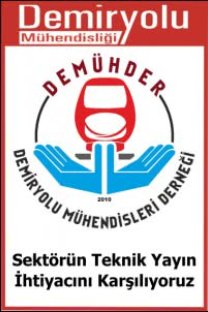Demiryolu Hızlı Onarımında Kaya Dolgu Beton Kullanımına Agresif Ortamların Etkisi
Raylı sistemlerde hizmet sürekliliği esastır. Çeşitli nedenlerle raylı sistemlerde meydana gelebilecek aksaklıkların veya arızaların en hızlı bir biçimde giderilmesi gerekir. Aksi takdirde, verilen taahhütlerin yerine getirilememesi sonucu maddi veya manevi kayıplar söz konusu olacaktır. Bu nedenle, demiryolu demiryolu hat yatağında meydana gelebilecek her türlü çökme veya toprak kayması gibi demiryolu trafiğini aksatabilecek olayların neden olduğu problemlerin kısa sürede çözümü gerekir. Bu çalışmada, demiryolu hatlarında meydana gelebilecek her türlü çökme veya toprak kayması gibi zeminde boşluk meydana getiren olayların neden olduğu bozulmaların hızlı ve güvenilir şekilde onarımı için ideal bir alternatif olan kaya dolgu betonların kullanımına agresif ortamların etkisi araştırılmıştır. Bu amaçla, üretilen standart silindir ve küp kaya dolgu beton numuneleri donma-çözülme çevrimleri ve sülfat etkisi olmak üzere iki farklı agresif ortama maruz bırakılmıştır. Agresif ortamlara maruz bırakılan betonlarda meydana gelen birim ağırlık, ultrases geçiş hızı, yarmada çekme dayanımı ile basınç dayanımı değişimleri irdelenmiştir. Ayrıca, kaya dolgu betonlar %0, 1 ve 3 oranlarında süper akışkanlaştırıcı içerecek şekilde üretilerek akışkanlaştırıcı içeriğinin kaya dolgu beton özelliklerine etkileri araştırılmıştır.
The Effect of Aggressive Environments on the Use of Rock-Filled Concrete in Railway Quick-Repair
Service availability is very important in rail systems. It is necessary to eliminate any problems or faults that may occur in rail systems as quickly as possible. Otherwise, pecuniary loss and intangible damages will be incurred due to failure to fulfil the commitments given. For this reason, the problems caused by all the kinds of collapses or landslides that may occur in the base, subbase of the railway and natural ground need to be solved in a short time. In this study, the effect of aggressive environments on the use of rock-filled concretes, which are an ideal alternative for the rapid and reliable repair of disasters that can create a gap in the ground such as all kinds of collapses or landslides on railway lines, have been investigated. For this purpose, standard cylinder and cube rock-filled concrete specimens are subjected to freeze-thaw cycles and sulfate effect. After exposure to these effects, changes in the unit weight, ultrasound pulse velocity, the splitting tensile strength and compressive strength of rock-filled concretes are investigated. In addition, rock-filled concretes were produced with 0, 1 and 3% superplasticizer and effect of superplasticizer content on the properties of rock-filled concrete is investigated.
Keywords:
Railway Quick Repair, rock-filled concrete, sulfate effect freeze-thaw cycles, plasticizer.,
___
[1] Y. Wang, F. Jin, Y. Xie, Experimental study on effects of casting procedures on compressive strength, water permeability, and interfacial transition zone porosity of rock-filled concrete. Journal of Materials in Civil Engineering, 28(8), 04016055, 2016.[2] Y. Xie, D.J. Corr, M. Chaouche, F. Jin, S.P. Shah, Experimental study of filling capacity of self-compacting concrete and its influence on the properties of rock-filled concrete. Cement and Concrete Research 56, 2014, pp.121–8.
[3] Y. Xie, D. J. Corr, F. Jin, H. Zhou, S. P. Shah, Experimental study of the interfacial transition zone (ITZ) of model rock-filled concrete (RFC). Cement and Concrete Composites, 55, 2015, pp.223-231.
[4] F. Jin, X. An, J. Shi, C Zhang, Study on rock-filled concrete dam, Journal of Hydraulic Engineering, 36(11), 2005, pp.1347-1352.
[5] I. Y. T. Ng, H. H. C. Wong, A. K. H. Kwan, Passing ability and segregation stability of self-consolidating concrete with different aggregate proportions, Magazine of Concrete Research, 58(7), 2006, pp.447-457.
[6] B. M. Aissoun, J. L. Gallias, K. H. Khayat, Influence of formwork material on transport properties of self-consolidating concrete near formed surfaces, Construction and Building Materials, 146, 2017, pp.329-337.
[7] N. Ghafoori, H. Diawara, A. Hasnat, Remediation of loss in flow properties of self-consolidating concrete under various combinations of transportation time and temperature, Construction and Building Materials, 192, 2018, pp.508-514.
[8] X. An, Q. Wu, F. Jin, M. Huang, H. Zhou, C. Chen, C. Liu, Rock-filled concrete, the new norm of SCC in hydraulic engineering in China, Cement and Concrete Composites 54, 2014, pp.89-99.
[9] S. Çelikten M. Canbaz, Akışkanlaştırıcı dozajının kaya dolgu beton özeliklerine etkisi, Uluslararası Marmara Fen ve Sosyal Bilimler Kongresi, 26-28.04.2019, Kocaeli, Türkiye.
[10] TS EN 12390-3, Testing Hardened Concrete – Part 3: Compressive Strength of Test Specimens, Turkish Standards Institute, TSE, Turkey, 2010.
[11] ASTM C 597-09, Standard Test Method for Pulse Velocity Through Concrete, ASTM, International, USA, 2009.
[12] TS EN 12390-6, Testing Hardened Concrete – Part 6: Tensile Splitting Strength of Test Specimens, Turkish Standards Institute, TSE, Turkey, 2010.
- ISSN: 2149-1607
- Yayın Aralığı: Yılda 2 Sayı
- Başlangıç: 2014
- Yayıncı: Demiryolu Mühendisleri Derneği
Sayıdaki Diğer Makaleler
Demiryolu Hızlı Onarımında Kaya Dolgu Beton Kullanımına Agresif Ortamların Etkisi
Serhat ÇELİKTEN, Mehmet CANBAZ
Kapsamı Genişletilmiş Bezgin Denklemlerinin Tanıtılması
Yüksek Hızlı Trenlerde Aerodinamik Tasarımın Önemi ve Uluslararası Standartlarda Yapılan Yenilikler
Raylı Ulaşım Sistemlerinde Tahrik Amaçlı Katı Hal Transformatörü Kullanımı
Uğur Emre Doğru, Özcan Kalenderli
Hatice Gül ÖNDER, Furkan AKDEMİR
Metro İstasyon İşletme Şeflerinin Vardiyalarının Hedef Programlama ile Çizelgelenmesi
